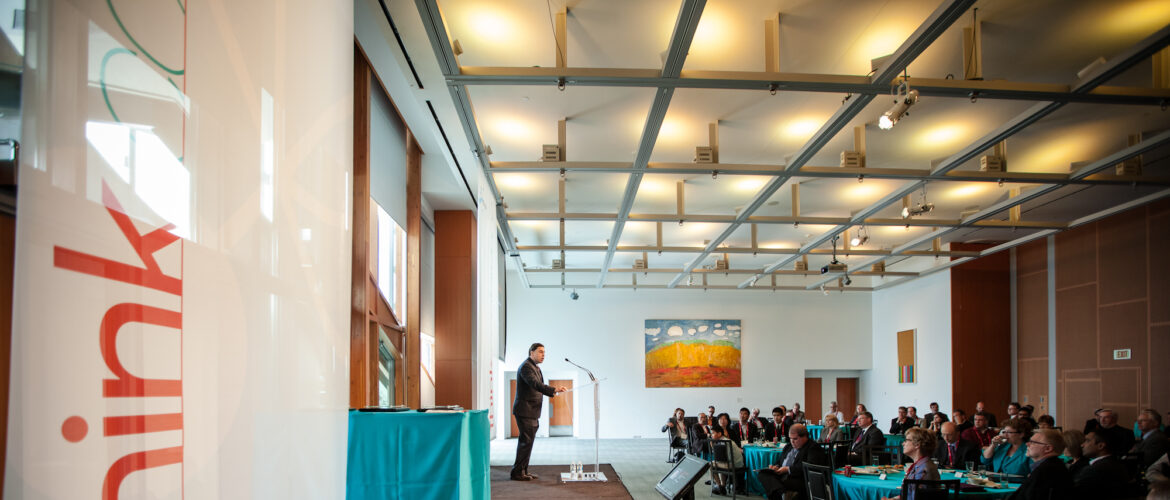
Greg McLeod, Principal, John A Leslie Public School
“Big Data” became “Extreme Data”, “last mile connectivity”, “SLA” (service level agreement – had to Google it) – this all seemed a bit over my head. I consider myself a learner so I thought, “keep an open mind.” When I listened I tried to think about how these topics impacted me as a K-8 Principal. It occurred to me that is was not so much the impact it had on me, but on the impact my students would have on the future. I started to question. I firmly believe that every time we question what we are doing we are beginning to engage in powerful professional development.
I spend time walking around and observing what is going on in my school, I stay on top of curriculum and innovation in pedagogy but the “data management” strand in many schools comes down to colourful graphs, scatter plots, and students doing surveys. It made me question as a school what are we doing to help students become not only critical consumers of data and information, but critical users of data?
Are we teaching students to:
- Look at data from multiple perspectives?
- Be aware of what is out there?
- Be aware of the role of social media and the power of social media to shape policy and affect change?
- To explore newer types of data like Sentiment data?
So I was in the right place after all, I already had questions to bring back to my school.
As information was presented on the scope of technology (modular data centers, IT pacs, cloud computing) and John Weigelt’s statement that, “by 2016 a billion people will have smart phones or tablets and have immediate access to powerful computing,” I started to think of the role of technology in education.
Technology has changed the landscape. When we think of technology’s role in education we often think of it as a tool. We use speech-to-text software, text-to-speech software, mind mapping programs to organize ideas, and presentation programs to present and share research. The internet has opened up access to information that was only available in large sets of wonderful looking, often leather bond books that sat on the bottom shelf in the library (that children hardly ever accessed, and usually the “R” volume was missing). We are getting good at using technology as a tool to enhance learning. What I don’t think we have been doing is looking at the impact of technology. How are people interacting with each other? Is it changing the way we make decisions? What role does social media play? Technology opens up a huge volume of information to us. We need to engage students in becoming critical thinkers.
Again I needed to bring this back to my reality and my own sphere of influence. As a school we need to examine the role of critical thinking and pushing our students’ ability to think critically. We need to look at increasing the focus on process and find ways to encourage student risk-taking and fostering innovative thinking. As school leaders we need to look at how we can encourage innovative thinking in students in a K-8 environment.
When I listened to concepts like sentiment data and measuring social media trends I started to think about how it impacts us at a school level. My kids are plugged in! Twitter and Facebook are basic requirements for any of my grade 6 and up students to simply exist as a social creature. With them so plugged in, I started to wonder not only about how we can reach kids using social media, but how can we use social media to impact kids? Does our school’s position on social media impact student perception and achievement? Do I need to monitor it? How?
I think these questions are all worth delving into.
If students and parents see the school as cutting edge and if the school has positive sentiment data on social media will the students feel more positive about school and about their ability to be successful in school?
I have been interested in student motivation. As an educator I am always interested in trying to motivate students to achieve their best results. I believe that it has a powerful impact on student achievement.
http://www.youtube.com/watch?v=pN34FNbOKXc&feature=youtu.be
I wondered, are the two connected? Can the public perception of the school have a positive impact on student achievement? And, if so, what are we doing as a school to increase and promote a positive sentiment towards the school? Are we using social media to the best of our ability?
After a day of learning (or maybe questioning) I went back to school. I wanted to make my questions public. I think by putting our wonderings and questions out there it makes us more accountable. I had lots of questions; my challenge was to take action on them. I hope to share my journey with you!
Editor’s note: Click here for more information on the 2013 THINK Conference

